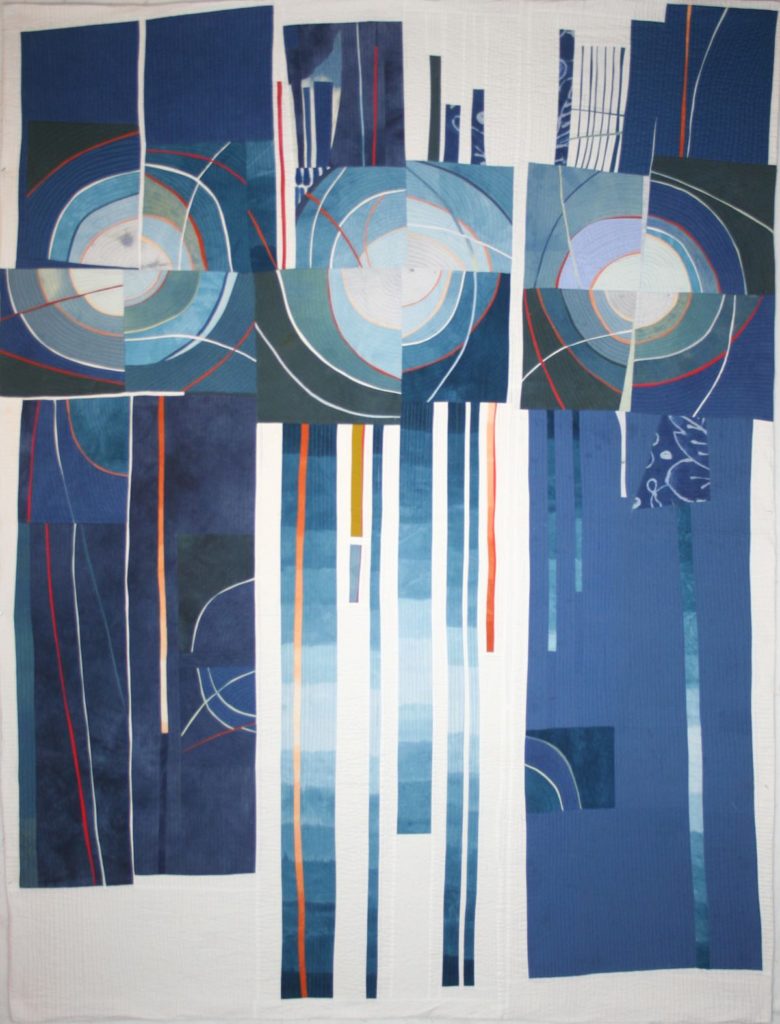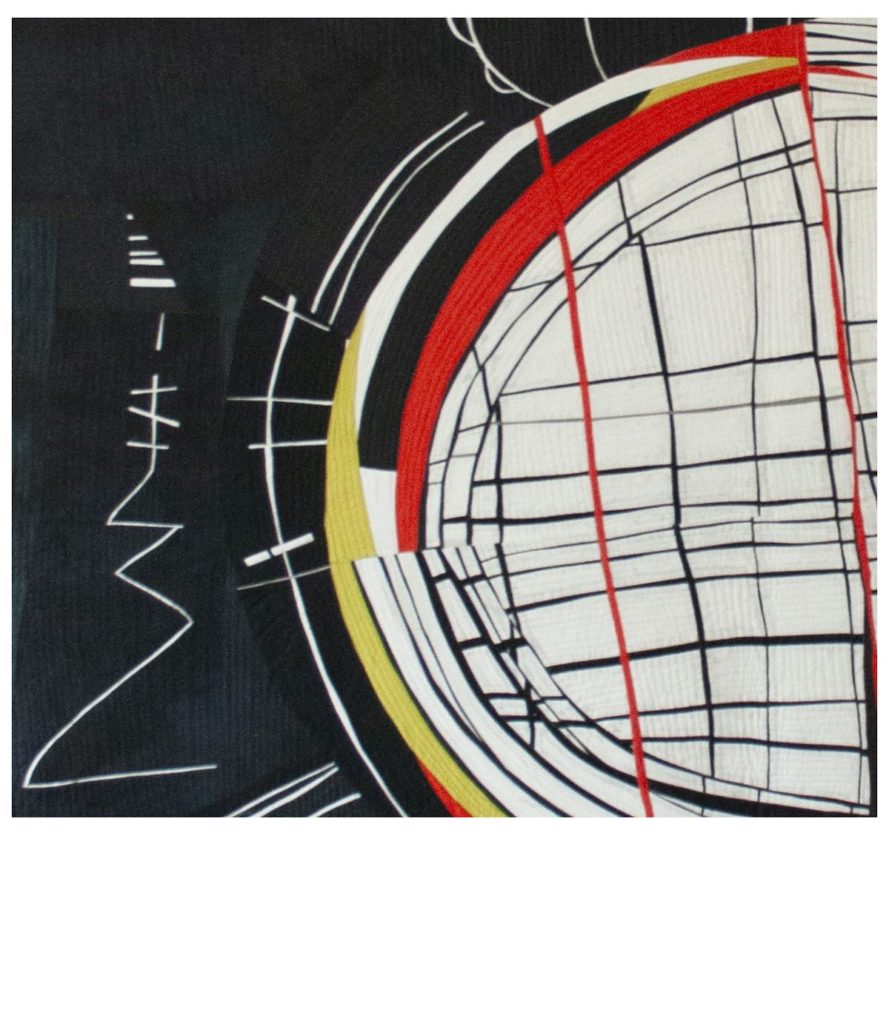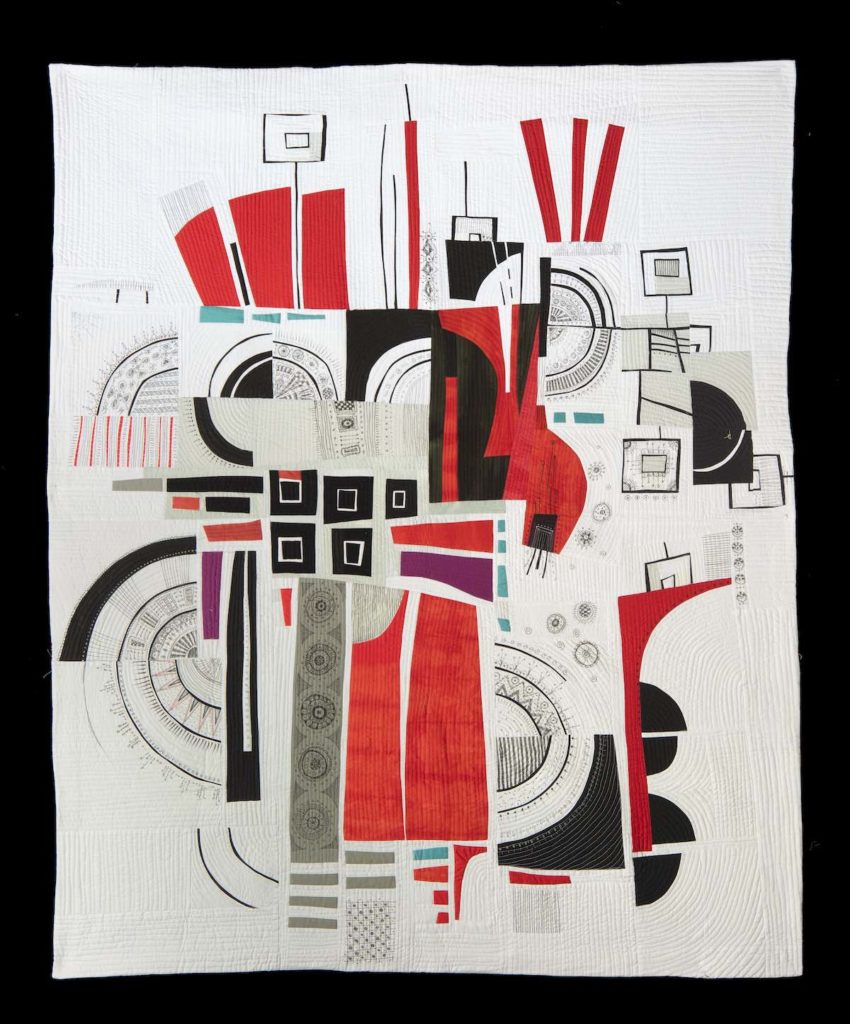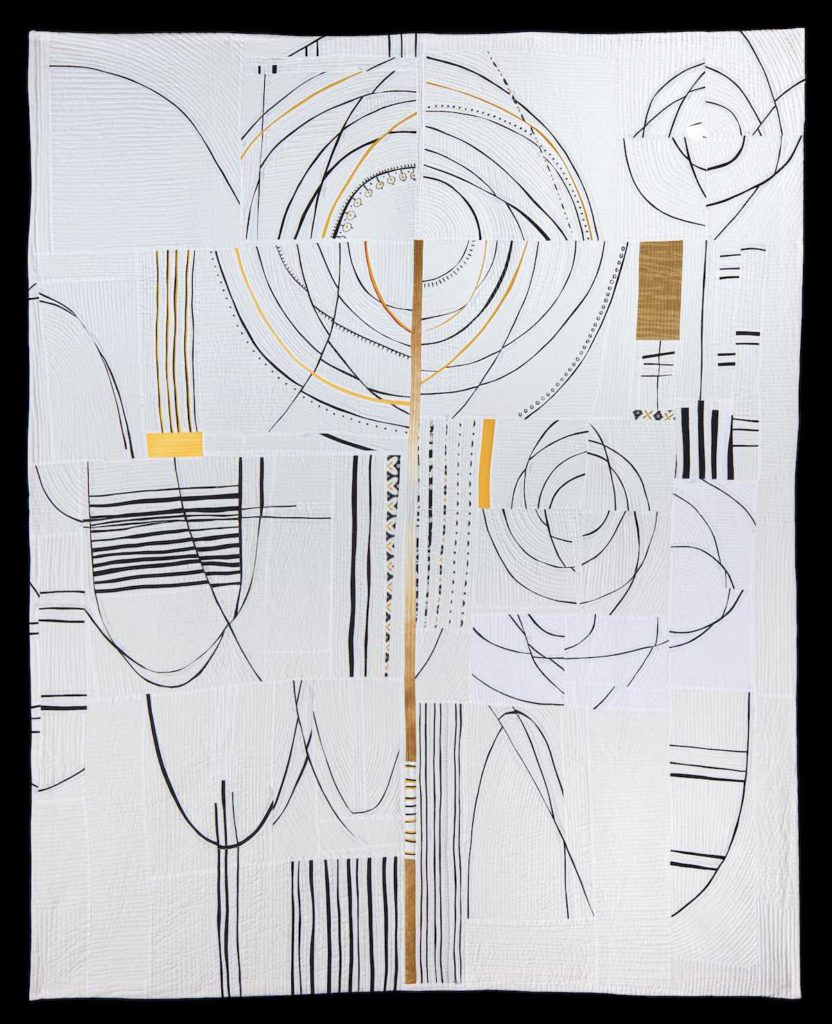Initially trained as a painter, textile artist Irene Roderick came to quilting when she was looking for ideas for a bed quilt (her first), and discovered the work of Denyse Schmidt, Gwen Marston and Nancy Crow. Irene was taken with the endless uses of color and pattern in improvisational quilting. So, that is the only kind of quilting Irene has ever done – she has never made a traditional quilt or worked from a pattern.

What was your path to quilting? How did early creative pursuits prepare you for working with textiles?
I have always been a painter and not a textile artist. I learned how to sew garments as a teen, but quilting was never on my radar. My grandmothers, mother, nor aunts were quilters or knitters or crocheters. My mother was left-handed and her attempts to teach me, a right-hander, to knit or crochet were disasters. It wasn’t until I retired from my administrative job at age 65 that I discovered quilting as an art medium.
I began painting at the age of 10 at the encouragement of a teacher who took time out of the school day to show me how to oil paint. I painted for pleasure and business for 55 years while I raised 4 boys. Finally, I got the opportunity to return to school when I was 46 and earned a Bachelor of Fine Arts degree. I was encouraged to continue my education by my faculty and earned a Master of Fine Arts degree from the California Institute of the Arts in California when I was 50 years old.
My practice in painting gave me the basic principles of color and design. I have a strong eye for pattern and balance through years of making paintings. The other gift of spending my life making things is that I am fearless. So, I understand the process of failure and artist’s block and success and criticism. That gives me the freedom to experiment and explore that is invaluable to my current work.
As an Amazon Associate I earn from qualifying purchases. Read more about our affiliate linking policy.
I have also always been drawn to the idea of combining fine art with function. I have constructed and painted furniture as well as painted clothing. And I have painted many murals. My storage unit is full of rolled painted canvases. I am not interested in creating any more wall art but want to create “textile paintings” that can be thrown in a washing machine and also keep a person nice and warm. I realize not many people are using my quilts to keep warm, but in a pinch, such as during a freak cold spell last winter, they are put into use over windows, doors and on floors to keep out the frigid air.


Where do you find inspiration for your work?
I know that it is a cliché that inspiration is everywhere, but I really believe it. While on walks, I take photos of flowers, trees, graffiti, tar, chalk drawings and anything else of interest. In addition, I take photos from my windows of trees, vines and people walking by. I love to look at art books, sewing books, quilting books, other craft books and magazines. I find that paintings and drawings in museums, on social media, in galleries as well as on buildings are always the best inspiration! Too much current art is based in video or installation, and they leave me cold.

Are there recurring themes in your work? What is it about a subject that inspires you to continue exploring it?
My all-time themes are feminist in nature. I have always dealt with the issues that women face especially with body image and media such as fashion magazine photos. I have studied the history of “women’s work”, especially lace-making, and other needlework. The positioning of women throughout history in all cultures fascinates me. So, I have often used the female form in my work as central subjects.
Recently I’ve noticed that, even though I work improvisationally, my quilts depict figures of some sort, not necessarily female. The isolation of the pandemic lockdown was ideal for my studio practice but was lonely. It seems I started creating creatures or people-esque characters, mostly human size to keep me company.
I also love playing with color and pattern. I could explore color relationships and the intricacies of patterns forever!

What inspired you to make your first quilt? How does your training as a painter influence your textile art?
A year prior to my retirement, I built a “tiny house” that is one room, 280 sq ft. I wanted to find a unique bed covering for the space, so I googled “modern quilt”, not realizing the term is a specific term for a style of quilt. That was when I discovered the quilts of Denyse Schmidt, Nancy Crow, Gwen Marston and more. I wanted that kind of quilt for my bed and decided to make my own. So, I took a basic quilting class and was hooked! I put down my brushes and built a design wall and started playing. Because I didn’t really know much about quilting except how to construct a 9-patch block, I threw fabric on the wall much as I would create a painting. I was not aware of quilting methods, rules or history.

Tell us more about your new book, Design Then Quilt; A Dynamic Guide to Creating Modern Quilts. What inspired you to write this book?
Design Then Quilt is an in-depth look at Design with a capital “D” – the practice of Design as pertains more often to Graphic Design or in an academic environment. This is Design as it has come to contemporary times through the aesthetic concepts of the Greeks and redefined by the Bauhaus in the 1920’s.
Through my teaching, I have noticed that many students have a vague concept of Design in the form of “rules” to follow for “good” design but are interested in learning more. Many of my students have either wanted to attend Art school but life got in the way or attended Art school many years ago and are interested in a refresher.
I began looking for a good text book about Design and couldn’t find what I considered a book that wasn’t too academic, too heavily based on Graphic Design (lots of typography) or too simple.
I decided to write my own book for fiber artists in understandable terms. Because I wanted the book to talk about Design for quilters, I ended up including sections on how quilts are constructed, materials used in quilting and how each of these decisions can impact a quilt.

When thinking about elements of design and the principles of design, what’s the difference? How should quilters consider them when working on a piece?
The elements of design are the ingredients (put in cooking terms). Line, shape, form, color, value, texture are “elements.”
The principals are the recipe; how these elements are put together to create a design (or delicious cake). Principals include movement, rhythm, proportion, balance, emphasis, et al.
When making a quilt, the most obvious elements considered are shape and color. Line (quilting and stitching lines, lines formed by the intersections of shapes, actual lines pieced) and value (more important than color!) should be right up there as part of a quilt design. The book explains how each of these decisions impact a design and how to use them successfully.

Do you have any favorite elements or principles?
I am known for the pieced lines I use in my quilts so I guess I have to say they are my favorite element. As an artist, though, color in all its complex glory is the most fun. Color and value are the core of every design and I can talk about these elements ad nauseum.


How would you recommend that beginner quilters think about design elements and principles when planning and executing their work?
Beginner quilters should study other quilts and artworks to see what appeals to them.
Keep a gallery of favorites and then study them closely. What colors are you drawn to? What styles do you love? Do you tend to admire minimal work? Is complexity of pattern and lots of color your favorite style?
Find the elements of design that your favorite images have in common and then study how they are arranged to create the principals (rhythm, balance, movement). It’s not a matter of copying, but a process to recognize what you like.
The more you study, the more you internalize and the more unique your own work will become.

What’s one tip to get started critiquing your own work?
I include a worksheet in the book that lists considerations for critique. This can be used in your studio or in a group. If you feel a design is lacking something the worksheet can help find the criteria on which to focus.
Is a color not doing what it should? Is the composition unbalanced? Take a photo and study your work on a computer screen while you are in a zoom meeting or on the phone. I find this very helpful to start “seeing” work in a new light (without raw edges, pins, strings) and clarifying what I am looking at.
I strongly advise setting up a group of 3-4 fellow artists to meet on a regular basis. This is not a group to “critique” in a negative way or even get advice, but it is very helpful to look closely at your own work and having to describe it. This clarifies things in your own mind. The idea of this group is to get fresh eyes on what you are doing and talk about problematic areas, not “design by committee.”

How would you suggest quilters find or start a small critique group?
Look for other quilters in your guild, on Instagram, at quilt shows, or any other place you run into artists, whose work you admire and who you think are at a similar place in their practice.
I have students ask me to suggest other quilters who might work for them. It’s important to choose someone whose advice you will appreciate and who you think will also listen to your own advice to them. It’s a give and take, not a workshop.

Not every piece of work is amazing. What do you do with your non-favorites?
I finish everything I start even if I think it’s definitely NOT amazing. I learn something from everything I make.
And unfortunately, I tend to hold on to everything as well. Sometimes I will give away a quilt or sneak it into a charity quilt pile hoping at least it will keep someone warm! One son uses my least favorites as sound dampers for his zoom calls.
I have also discovered that even if I don’t love a quilt, other people might find it interesting. I am considering doing a massive cleanout and auctioning off some quilts for good causes….

Tell us about your process in creating a quilt. How do you get from initial spark to completed work?
My only technique is Improv quilting. I get bored following patterns and endless repetition. I want to be engaged at every level of what I am making. Improv quilting requires constant consideration of every step of the process. I begin with a single piece of fabric on my design wall and build the quilt one piece at a time until the design is complete. Next, I must find a way to sew all the pieces together. Always a difficult process! After the design is all in one piece, the quilting begins. I quilt on a Bernina Q20 sit down quilting machine and do the quilting improvisationally as well.

How does working improvisationally best express what you want to say with your art?
I am not a political artist. I am not comfortable around philosophical discourse (my husband was a professor of Philosophy and I listened to waaaay too many arguments through the years). That being said, I do have strong opinions and feelings. I believe that by giving up control, working intuitively and without intention, brings my thoughts about the world into my quilts.



How does improv quilting keep you engaged in the process?
Improv keeps me engaged every step of the process. My process is about constantly responding to what is on the design wall in front of me. As most of my students will tell you, the “engineering” or piecing of an improv quilt demands constant attention and decision making. Then, there’s the quilting itself. I usually quilt ¼” apart straight lines but change the directions of those in each section.


What is the main takeaway you want readers to gain from your first book, Improv Quilting?
My main purpose for writing the book is to introduce my method of making an improv quilt to others. I have found so much freedom and joy through this process and I want everyone else to find the same feelings! I hope the book encourages all quilters to let go of fears and rules and try something new. Of course, I had to come up with a method of explaining how I work to put it into book form, but it’s the absolute freedom of just playing with fabric, pattern and color that I hope will come across.
Some people equate “improvisation” with “haphazard”, but that’s not entirely accurate, is it? What are some of the design decisions you make when composing an improv quilt?
I make very careful deliberations every step of my process. I begin a quilt with a single piece of fabric or left-over component or a new component.

Do you have a dedicated space for creating? If so, what does it look like?
I live in a tiny house (280 sq ft) and it is basically a studio with a kitchen along one side, the bath in a corner and a bed in another corner. My sewing and quilting machines, cutting table, ironing board and design wall take up the rest of the space. I live, eat and sleep with my work and I always have. Even when the family was young, I had paintings or drawings leaning against the walls and paint tubes on the floor.

What are the indispensable tools and materials in your studio? How do they improve your work?
My design wall is the center of my creative process. I can sew by hand or cut with scissors, if need be, but I must be able to see the work as I make it.

Do you use a sketchbook or journal? How does that help your work develop?
I don’t sketch or journal. But I do take photos or save images of art from Instagram. I love to work directly. I discovered a long time ago that I work best “life size.” My sketches didn’t translate into bigger works. My bigger works don’t shrink to sketch-book size. Journaling would probably be good for me, but I feel silly doing it and especially reading it later.

What plays in the background while you work? Silence? Music, audiobooks, podcasts, movies? If so, what kind?
I listen to music – bluegrass, rock and roll, country, oldies. When I tire of that, I listen to books on tape that I get free from the library. I love detective and murder mysteries the best!


Do you enter juried shows? Do you approach your work differently for these venues?
Yes, I enter juried shows. I like to get my work in front of the public and these are the only venues readily available. I do not work differently for the venues. If there’s a theme, I look for a quilt that fits. Usually, the themed shows require smaller quilts than I make so I don’t do many of those. I discovered a couple of years ago that quilt shows are expensive. First there are entry fees, then shipping to and from. I can spend over $100 on a single exhibition. I try to choose the shows I enter more carefully these days and stick to venues with large audiences.

Which artists do you admire? What draws you to their work?
In the field of textiles, I will always admire the work of Gwen Marston and Nancy Crow. The early minimal quilts that Denyse Schmidt made were the initial spark of my quilt making interest. I saw her “Simple Quilt, Queen” on-line using two very large areas of two different oranges and decided I needed to start exploring the world of quilts. I have always loved the stitching of Paula Kovarik and her wonderful sense of humor. She combines quirk with politics in a way that is both playful and sinister. I discovered the sensuous quilting of Pamela Wiley on Instagram which transformed my thinking about what the quilting can do on a quilt to enhance depth and design.
Of course, the prints and paintings of Friedensreich Hundertwasser were the inspiration behind my early improvisational work. His colors and shapes are so easily translated into quilting. I love the Abstract Expressionist painters.
Other than those specifics, I love many artists’ work. I am attracted to color and pattern and how many thousands of ways they can be combined. My students constantly amaze me with their talent and have brought me so many new ideas to explore.


Do you think that creativity comes naturally to people, or do you think creativity is a skill that people can learn?
I think the need to create is innate in all of us. For some of us it is a stronger urge or (for me) an obsession. Because of that, I’ve spent my entire life being creative. I taught drawing for years to people who insist they can’t draw but discover that, of course, they can. It takes practice to “see” the world as an artist, but I also don’t think creativity refers to only artmaking. I see engineers, chefs, scientists, machinists, restaurant servers, hotel managers etc. as creative people. I think creativity is seeing and being in the world through imagination. It takes many forms. If you want to sew a perfect ¼” seam or a decent “Y-seam” – that takes skill which takes practice.


Do you lecture or teach workshops? How can students/organizers get in touch with you to schedule an event?
I do teach and lecture. My email address is hixsonir@utexas.edu and that is the best way to reach me. When I teach, I try to put it on Instagram. Right now, I’m teaching my beginning workshops through CraftNapa and Gotham Quilt Store (Zoom). If all goes well, I’ll be doing in-person workshops at Pacific Northwest Art School on Whidbey Island, Quilting by the Lake in upstate New York, at “Stitch” in Durango, CO, and some guild visits in New Mexico and Chicago. I announce advanced workshops during the beginning workshops. I prefer continuing students in my “Dance Choreography: Finding Your Voice,” and “Dancing Design” (elements and principles of Design through critique).
Tell us about your website. What do you hope people will gain by visiting?
I don’t keep my website up to date very well. It is mainly a show and tell of all my quilts. I hope seeing my work encourages and inspires people to get out and make something for themselves.
Interview posted January 2022, updated December 2024
Browse through more improv quilt inspiration on Create Whimsy.

